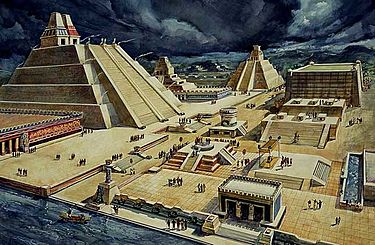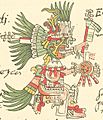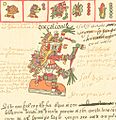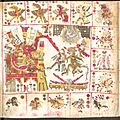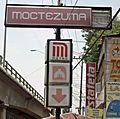Aztecs facts for kids
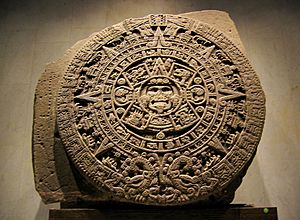
The Aztecs were Native American people who lived in a region called Mesoamerica. They built a powerful empire that lasted from the 14th century to the 16th century.
The name "Aztec" comes from "people from Aztlan." Legends say Aztlan was the first home of the Aztecs. "Aztlan" means "place of the herons" in the Nahuatl language.
Sometimes, "Aztec" refers only to the people of Tenochtitlan. This was a big city built on an island in Lake Texcoco. These people called themselves the Mexica. This is why the country is now called Mexico. They also called themselves the Nahua, which is why their language is called Nahuatl.
Contents
The Aztec Story: How an Empire Grew
Before the Aztecs became powerful, many different city-states lived in Mesoamerica. These were like small cities with farms around them. Each city-state had its own ruler. Around 1100 AD, these groups began fighting for land and resources.
Historians believe the Aztecs arrived in central Mesoamerica around 1200 AD. They came from what is now northwest Mexico. At first, they were seen as outsiders. They lived as hunter-gatherers, eating snakes and small animals. This was very different from the settled farming communities.
For about 100 years, the Aztecs wandered around. They were often forced out of places. Finally, they settled on some small, swampy islands in the middle of Lake Texcoco. By 1325, they had built their city, Tenochtitlan, there. Tenochtitlan slowly grew into a very strong city-state.
By about 1400, three city-states had become small empires. In 1428, two of these empires fought the Tepanec War. The Texcoco empire formed an alliance with other strong city-states, including Tenochtitlan. They won the war.
These allies were supposed to share power equally. But by 1430, Tenochtitlan became the most powerful. It became the capital city of the Aztec Empire. Its ruler became the 'high king' of the entire Empire.
-
Map of Mesoamerica
-
Map of city-states in the 16th century
The Mighty Aztec Empire
The Aztec Empire existed from about 1438 AD to 1521 AD. When it was at its largest, it covered most of Mesoamerica. It controlled about 11 million people.
Tenochtitlan: The Capital City
Tenochtitlan was the capital city of the Aztec Empire. It was one of the greatest cities in the world at that time. By the early 1500s, over 200,000 people lived there. This made Tenochtitlan the largest city in the Americas before Christopher Columbus arrived.
Today, Mexico City covers the entire area where Tenochtitlan once stood.
Aztec Beliefs and Gods
The Aztecs believed in many gods. Two very important gods they worshipped were Huitzilopochtli, the god of war and the sun, and Tlaloc, the rain god. Another important god was Quetzalcoatl (feathered snake), who was the god of learning and civilization.
The Aztecs performed many rituals to keep their gods happy. They believed this helped prevent the world from ending. They thought the gods had created them. They also believed that giving back the gift of life through sacrifices was the most powerful way to honor the gods. The Aztecs thought their gods were always fighting. Hearts and blood from sacrifices gave strength to the good gods to fight the evil ones. These sacrifices often happened at the Templo Mayor, their great pyramid temple.
What Did Aztecs Eat?
The Aztecs ate plants and vegetables that grew well in Mesoamerica. Their main foods were maize (corn), beans, and squash. They often used tomatoes and chili as spices.
Aztec markets sold many things like fruit, vegetables, flowers, dogs, birds, and cocoa beans. They also created chocolate. However, they did not have sugar, so their chocolate was a strong liquid with chili in it. They also made an alcoholic drink called chocolatl. Many of these foods later spread around the world.
Aztec Society and Daily Life
Aztec society had different social classes. People had different social statuses. The most important people were the rulers. The Aztecs' first king was Acamapichtli. Their last king was Cuauhtemoc. He surrendered the Aztec Empire to Hernan Cortes during the Spanish conquest of the Aztec Empire.
Next came the nobles. These were powerful government members, great warriors, judges, and priests. They had a high social status.
The next group was the commoners. These were the everyday workers of the Empire. Most of them farmed, ran stores, or traded goods. Other commoners included artisans, regular soldiers, and fishers. Commoners could own land as a group or family. But a single person could not own land alone.
The lowest social classes were serfs and then slaves. Slaves had no rights. They were bought and sold at Aztec markets. Some prisoners of war were also sacrificed to the gods. However, if slaves had money, they could buy their freedom and become commoners.
For most of the Aztec Empire's history, it was very hard to change social classes. If you were born into a class, you usually stayed there your whole life.
Aztecs had strict punishments for crimes that seem simple to us today. For example, a person could face the death penalty for cutting down a living tree. Other serious crimes included moving a field's boundary to steal land, major theft, treason, and causing public trouble. A commoner could also get the death penalty for wearing cotton.
-
Aztec 'high lords', who were in the top social class
-
Merchants, members of "the commoners," carry things they want to sell a long way away
Learning and Knowledge
The Aztecs studied astrology. They used the movements of the planets and stars to create different calendars. They had an accurate calendar with 365 days, based on the sun's movements. They also had a religious calendar with 260 days.
The Aztecs also studied and taught many complex subjects. These included geometry, mathematics, debate, law, music, poetry, architecture, and agriculture.
Aztec Sports
The most popular Aztec sport was Tlachtili. They played this game with rubber balls. The goal was to shoot the ball into a vertical hoop using only their knees. The first team to score won the game.
The End of the Aztec Empire
Between 1519 and 1521, the Spanish conquistador, Hernán Cortés, made allies with Tlaxcala and other enemies of the Aztecs. The conquistadors defeated the Aztecs. They took over their empire and made it a Spanish colony. Some Aztecs did not want to fight Cortés's soldiers because they thought the Spanish were gods.
Aztecs Today
Today, many Mexicans have Aztec and other Native American forefathers. People still use Aztec symbols in Mexico. On the Mexican flag, there is a picture of an eagle on a cactus with a snake in its mouth. This was an Aztec symbol. Even the name Mexico is an Aztec word.
Images for kids
-
A page from the Codex Boturini depicting the departure from Aztlán
-
The Valley of Mexico with the locations of the main city-states in 1519
-
The meeting of Moctezuma II and Hernán Cortés, with his cultural translator La Malinche, 8 November 1519, as depicted in the Lienzo de Tlaxcala
-
Aztec 'high lords', who were in the top social class.
-
Jaguar warrior uniform as tax pay method, from Codex Mendoza
-
Pre-Hispanic "Tepeyac" Road of city-state of Tlatelolco ruins with semi-underground unidentified small and simple buildings, probably houses (left). Tlatelolco archaeological site.
-
Cultivation of maize, the main foodstuff, using simple tools. Florentine Codex
-
Great Temple in Historic center of Mexico City
-
The "Aztec calendar stone" or "Sun Stone", a large stone monolith unearthed in 1790 in Mexico City depicting the five eras of Aztec mythical history, with calendric images.
-
Ma (hand) and pach (moss). In Nahuatl, handmoss is synonym of raccoon.
-
Frame drum huehuetl played by a youth in Aztec-themed costume in Amecameca, State of Mexico, 2010
-
The Coatlicue statue in the National Museum of Anthropology
-
José Sarmiento de Valladares, Duke of Moctezuma de Tultengo, viceroy of Mexico
-
Modern Mexico flag, depicting a Mexican eagle perched on a prickly pear cactus devouring a rattlesnake. The design is rooted in the legend of the Aztec people.
-
Motecuhzoma II's Teocalli of the Sacred War emblem, which depicts an eagle on a cactus holding the glyph for war, atl-tlachinolli in the middle of a lake, the mythical symbol which the Aztecs were said to have seen at the site where the city of Mexica was founded.
-
Monument to Cuauhtémoc, inaugurated 1887 by Porfirio Díaz in Mexico City
-
Detail of Diego Rivera's mural depicting the Aztec market of Tlatelolco at the Mexican National palace
-
President Porfirio Díaz in 1910 at the National Museum of Anthropology with the Aztec Calendar Stone. The International Congress of Americanists met in Mexico City in 1910 on the centennial of Mexican independence.
-
Urban standard details; Mexico-Tenochtitlan wall remnants stone bricks in Templo Mayor Museum (Mexico City)
-
Las Tortilleras, an 1836 lithograph after a painting by Carl Nebel of women grinding corn and making tortillas.
-
Chapulines, grasshoppers toasted and dusted with chilis, continue to be a popular delicacy.
See also
 In Spanish: Civilización mexica para niños
In Spanish: Civilización mexica para niños






